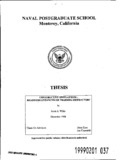Army Reserve training seat allocation
| dc.contributor.advisor | Olwell, David | |
| dc.contributor.author | Brown, Sylvester H. | |
| dc.date.accessioned | 2012-03-14T17:47:20Z | |
| dc.date.available | 2012-03-14T17:47:20Z | |
| dc.date.issued | 2002-06 | |
| dc.identifier.uri | https://hdl.handle.net/10945/5957 | |
| dc.description.abstract | This thesis reduces wasted Reserve training seats by one-fourth, improving resource use and increasing readiness. The Army Reserve currently uses approximately 80% of its scheduled Initial Entry Training seats each year (wasting over 3000 seats for soldiers assigned to Troop Program Units). Reasons include misalignment of Basic Combat Training with follow-on Advanced Individual Training, scheduling too many seats during a period when targeted trainees are not available for training, and limited training capacity for specific specialties that units require for improved readiness. The Office of the Chief, Army Reserve Personnel Division negotiates with other Army components in the Training Resource Arbitration Panel to make adjustments to schedules of the Army Training Requirements and Resources System. Input from Recruiting Command and expert judgment is inadequate. This thesis allocates Army Reserve seats among competing needs of Army components and within available resources to increase seat utilization, thus increasing readiness. We validate the model by comparing historical training with model results and use these results to establish feasible training schedules to meet future goals and respond to readiness, recruiting and retention in the Army Reserve. This model provides a Reserve training schedule for FY 03 that optimally allocates funded training resources to improve unit readiness, achieves fiscal year goals established by the Structure Manning Decision Review, and eliminates mismatches between basic and advanced training that caused lost training resources in the past. The Army Reserve can set various goals and establish a schedule that remains responsive to historical starts. When specialty readiness prioritization occurs, users will simply establish weights for these priorities as part of the input data. This model requires data inputs from the Army Training Requirements and Resources System and the Total Army Personnel Database - Reserve. We expect a reduction in training seat loss from 20% to approximately 15%. This means that over 15,000 Reserve soldiers will become specialty qualified during FY 03 versus 13,000, improving readiness in Troop Program Units. The Personnel Division should implement this model to help in the Training Resource Arbitration Panel process. | en_US |
| dc.description.uri | http://archive.org/details/armyreservetrain109455957 | |
| dc.format.extent | xxii, 81 p. : ill. ; | en_US |
| dc.publisher | Monterey, California. Naval Postgraduate School | en_US |
| dc.rights | This publication is a work of the U.S. Government as defined in Title 17, United States Code, Section 101. Copyright protection is not available for this work in the United States. | en_US |
| dc.subject.lcsh | Linear programming | en_US |
| dc.subject.lcsh | Operations research | en_US |
| dc.title | Army Reserve training seat allocation | en_US |
| dc.type | Thesis | en_US |
| dc.contributor.secondreader | Buttrey, Samuel E. | |
| dc.contributor.department | Operations research | |
| dc.subject.author | Optimization | en_US |
| dc.subject.author | Linear Programming | en_US |
| dc.subject.author | GAMS | en_US |
| dc.subject.author | Operations Research | en_US |
| dc.subject.author | Scheduling | en_US |
| dc.subject.author | Training | en_US |
| dc.description.service | Major, United States Army Reserve | en_US |
| etd.thesisdegree.name | M.S. in Operations Research | en_US |
| etd.thesisdegree.level | Masters | en_US |
| etd.thesisdegree.discipline | Operations Research | en_US |
| etd.thesisdegree.grantor | Naval Postgraduate School | en_US |
| dc.description.distributionstatement | Approved for public release; distribution is unlimited. |
Files in this item
This item appears in the following Collection(s)
-
1. Thesis and Dissertation Collection, all items
Publicly releasable NPS Theses, Dissertations, MBA Professional Reports, Joint Applied Projects, Systems Engineering Project Reports and other NPS degree-earning written works.





